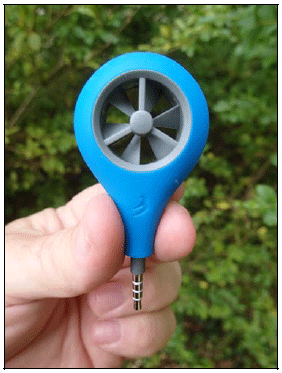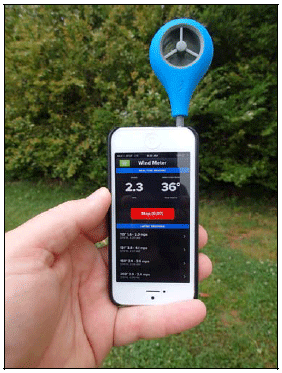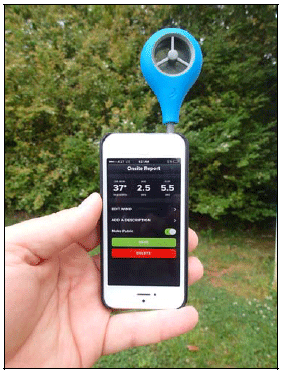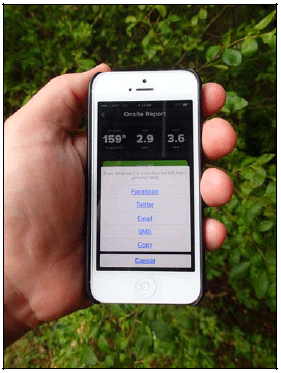Smart Phone Wind Meter
Published: May 24, 2014
By: Dr. Mike Czarick and Dr. Brian D. Fairchild (University of Georgia)
Figure 1. Weatherflow Wind Meter.

Figure 2. Weatherflow Wind Meter connected to Iphone.

Accurately measuring wind speed in a tunnel-ventilated poultry house is of the utmost importance when assessing its house’s ability to keep birds cool during hot weather. Though there are a dozens of wind meters available on the market today, there is a new one that has many unique features that poultry producers might find particularly beneficial. The inexpensive Weatherflow Wind Meter* ($35) is designed to work with either IOS or Android devices. The small vane anemometer simply plugs into the headphone jack and once you download the free app you are ready to measure wind speed (Figure 1).
You can set up the app to display wind speed in mph, knots, km/hr, Beaufort, or m/sec. Though there is no ft/min option, you can set your smart phone to measure wind speed in “m/sec” and simply multiply the measurement by 200 (i.e., 2.3 m/sec = 460 ft/min). To measure wind speed you simply hold your smart phone where you want to determine the wind speed then touch the “start” and your smart phone starts recording the wind speed for a programmable period of 3 seconds to 60 seconds (Figure 2). At the end of the recording period your smart phone displays the average wind speed, maximum wind speed, along with the direction in which the measurement was taken (Figure 3). You are then provided the option of adding notes to wind speed measurements (ie., farm name, location), which is saved on your smart phone, as well as the option of emailing, messaging, etc. the measurement to anyone (Figure 4).
Figure 3. Weatherflow app recording wind speed.

Figure 4. Weatherflow app wind speed record sharing options.

The vane anemometer is encased in a sturdy rubberized coating which should protect it from damage if dropped. The anemometer has a reported range of 2 mph to 150 mph with accuracy of +/- 0.05% at the top end of its range and within 20 ft/min if held 15 degrees off-axis. Our field measurements found the Weatherflow Wind Meter to produce average wind speed readings very comparable to other commonly used wind meters.
To produce the most accurate, repeatable, and representative wind speed measurements with the Weatherflow Wind Meter or any other anemometer, these rules should be followed:
- Wind speed measurements generally should be taken between four and five feet above the floor. Measurements taken at floor level tend to be very turbulent when birds are present, making the accuracy of such measurements highly suspect.
- Anemometers should be held at arm’s length when taking measurements.
- Make sure the face of the anemometer is held perpendicular to the direction of air movement.
- When taking measurements in empty houses make sure that all equipment (i.e. feeders and drinkers) are lowered to the level they will be when birds are present.
- Wind speed measurements should generally be taken 40' to 100' from the tunnel fans. Make sure that there are no side wall furnaces or partial house curtains in the vicinity of the measurement location.
- In houses with deflector curtains measurements should be made half way between the deflector curtains.
- Measurements should not be taken on windy days. Exterior winds can lead to highly variable air velocity measurements within a house.
- The best location to measure an overall representative wind speed is roughly ten feet from the side wall near the outside feed line.
- Wind speed measurements should not be taken in the center of a house. This typically represents the highest velocity in a house and from a heat-stress-management standpoint is not as representative as an average or a feed line measurement.
- Wind speeds in a house can vary significantly over the course of a minute. To produce the most accurate readings, average air velocity measurement should be taken over at least a 30-second period, then repeated a minute later.
This article was originally published at UGA Cooperative Extension Poultry Housing Tips Vol. 26 no. 2, March 2014. https://www.poultryventilation.com/spreadsheets.
Related topics:
Authors:
University of Georgia
University of Georgia
Recommend
Comment
Share

Would you like to discuss another topic? Create a new post to engage with experts in the community.









.jpg&w=3840&q=75)